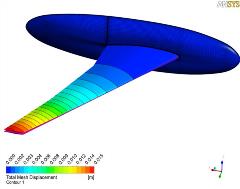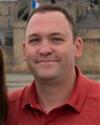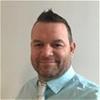Higher Fidelity Designs for the Aerospace Industry with Fluid-Thermal Structural Interaction (FTSI) Online

- A unique opportunity to dive in depth into high fidelity Fluid Thermal Structural Interaction (FTSI) modeling techniques
- All students will receive an AIAA Certificate of Completion at the end of the course
Overview
The current trends in the Aerospace and Defense industry are accelerating the existing focus on environmental sustainability, performance improvement, safety enhancements, and reduction in costs and time. All of these are complex initiatives that require competing design and business priorities to fit together seamlessly. Designing with close performance margins and balancing functional requirements with material and production costs requires uncompromised understanding of the physics involved. In other words, the closer the design comes to optimal design, the more important capturing all the physics with high fidelity becomes. Simulation complements the design process all the way from conceptual stage to assessing the performance in operation. The journey of pervasive simulation starts with a single physics but does not stop there. As complexity grows and the design envelope narrows, companies start the journey onto more complex simulation strategies – into Multiple physics and then into Multiphysics. Multiphysics modeling can have many flavors and many possible couplings of physics areas. This training will focus on modeling techniques for high fidelity Fluid Thermal-Structure interactions (FTSI) with several use cases that are relevant to the A&D industry space.
Though Ansys CFD software will be used in the course to illustrate example models, the course content will focus on generalized physical principles that are applicable to all types of CFD and Structural solvers regardless of your software tool of choice.
- Understand the fundamentals of Fluid-Structure interaction modeling
- Learn about best practices in setting up FTSI models
- Walk through tutorials and setup of use cases relevant to the A&D space including
- Aero-shell
- Turbo Flutter
- High fidelity Aeroelasticity
- Panel flutter
- Sounding rocket re-entry
- Solid Fuel Motor
- Tank sloshing
- Flexible Valves
The course is intended for engineers and physicists at all levels of expertise interested in modeling real-life FTSI problems. The initial lectures will focus on fundamentals of FTSI modeling with a demo of setting up a basic case followed by hands-on practice on some advanced applications. The audience is expected to have basic knowledge of the subject.
Type of Course: Instructor-Led Short Course
Course Length: 1 day
AIAA CEU's available: Yes
Course Outline
- Module 1: Introduction to FTSI, Part I
- Module 2: Introduction to FTSI, Part II, simulation best practices and demo example
- Module 3: Overview of FTSI modeling practices: 1-way, Live setup of Aeroshell
- Module 4: Overview of FTSI modeling practices: 2-way: Live setup of hi-fi aeroelasticity
- Module 5: Overview of FTSI modeling practices: Turbomachinery aeromechanics simulations
- Module 7: Best practices in FTSI modeling: Live setup of sounding rocket
- Module 7: Overview of valve FTSI. Live setup of flexible valve case (contacts)
- Module 8: State-of-the-art in experimental techniques for the validation of FTSI simulations

Dan Williams is a director of R&D at Ansys in the Fluids business unit. He has 24 years of experience in CFD development work, leading CFD solver development for Ansys CFX, Fluent and Discovery AIM. In addition, he spent a number of those years working with the Ansys System Coupling team to develop the Ansys platform for co-simulation and mapping capabilities for fluid-structure interaction simulations.

Ryan O’Connor is a Lead Application Engineer at Ansys. Ryan joined Ansys after earning his BASc in Mechanical Engineering from the University of Waterloo in 2005. At Ansys, Ryan initially provided support and professional services for CFX and Ansys Turbo Tools after which he focused his attention on Fluent, especially as it relates to Fluid-Structure Interaction (FSI). He is one of Ansys’s North American FSI experts.

Henry Vu is a Lead Application Engineer at Ansys providing technical support to customers for both structural and fluids simulations for 5 years focusing majorly on Aerospace industry. Prior to Ansys, he spent several years working as a simulation expert in both the Aerospace and Energy industries. Henry received his PhD in Mechanical Engineering from the University of California, Riverside.

Scott Marinus is a Senior Applications Engineer with 10 years of experience in aerospace industry prior to joining to Ansys. Scott has been with Ansys for 17 years working closely with customers in the A&D space on Multiphysics applications.

Walter Schwarz is an engineering simulation expert with over 30 years of experience in the areas of flow modeling, heat transfer, and turbulence who currently is a Principal Application Engineer for the ANSYS Customer Excellence (ACE) Team. His application expertise covers all areas of aerospace & defense applications, power generation (fossil, nuclear, solar, wind), contaminant & pollutant dispersion, external airflow around buildings, indoor environmental modeling (hvac), and data center cooling. Dr. Schwarz received his PhD degree in Mechanical Engineering from Stanford University and prior to joining Fluent Inc. in 1996, Dr. Schwarz had worked at Westinghouse in the nuclear industry and had also been an assistant professor of mechanical engineering at Stevens Institute of Technology.

Bill Holmes is a Principal Application Engineer at Ansys with over 25 years experience in the area of turbomachinery design and analysis. One of his focus areas at Ansys is aeromechanics, including blade flutter and forced harmonic respose simulations. Prior to joining Ansys in 2004, Bill obtained a masters degree at Western University in London, On. Canada and worked as a turbomachinery design engineer at Siemens for 7 years.

Andrew Neely is a Professor at UNSW Canberra where he leads a research team investigating fluid-thermal-structural interactions on high speed vehicles via novel experiments. He works closely with a range of defence agencies in Australia and the US as well as with industry partners. His work has supported flight test programs for DSTG/AFRL and for ESA. While he specialises in hypersonic systems he also worked at the University of Oxford for a number of years on gas turbine systems for Rolls Royce.
Russ Prater, PhD is a Senior Application Engineer at ANSYS. Prior to working at ANSYS he spent 7 years as a thermal and fluids science engineer at Cummins Fuel Systems and in that role developed the internal workflows for co-simulations between the structural and fluid simulation teams. His doctoral thesis simulated the bending motion of a diesel injector needle via a coupled FSI simulation.
AIAA Training Links
For information, group discounts,
and private course pricing, contact:
Lisa Le, Education Specialist (lisal@aiaa.org)
